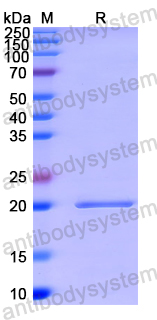Catalog No.
YHJ34901
Expression system
E. coli
Species
Homo sapiens (Human)
Protein length
Glu270-Lys438
Predicted molecular weight
20.66 kDa
Nature
Recombinant
Endotoxin level
Please contact with the lab for this information.
Purity
>90% as determined by SDS-PAGE.
Accession
Q92947
Applications
ELISA, Immunogen, SDS-PAGE, WB, Bioactivity testing in progress
Form
Lyophilized
Storage buffer
Lyophilized from a solution in PBS pH 7.4, 0.02% NLS, 1mM EDTA, 4% Trehalose, 1% Mannitol.
Reconstitution
Reconstitute in sterile water for a stock solution. A copy of datasheet will be provided with the products, please refer to it for details.
Shipping
In general, proteins are provided as lyophilized powder/frozen liquid. They are shipped out with dry ice/blue ice unless customers require otherwise.
Stability and Storage
Use a manual defrost freezer and avoid repeated freeze thaw cycles. Store at 2 to 8°C for frequent use. Store at -20 to -80°C for twelve months from the date of receipt.
Alternative Names
Glutaryl-CoA dehydrogenase, mitochondrial, GCD, GCDH
Glutaric aciduria type-1 in a teenager with nutritional vitamin B12 deficiency: coexistence of two treatable conditions., PMID:40280570
Impairment of neuromotor development and cognition associated with histopathological and neurochemical abnormalities in the cerebral cortex and striatum of glutaryl-CoA dehydrogenase deficient mice., PMID:39522695
Genetic Polymorphisms Associated with Fetal Hemoglobin (HbF) Levels and F-Cell Numbers: A Systematic Review of Genome-Wide Association Studies., PMID:39518961
Rewiring Lysine Catabolism in Cancer Leads to Increased Histone Crotonylation and Immune Escape., PMID:39462882
Use of the Novel Site-Directed Enzyme Enhancement Therapy (SEE-Tx) Drug Discovery Platform to Identify Pharmacological Chaperones for Glutaric Acidemia Type 1., PMID:39312412
Preserving mitochondrial homeostasis protects against drug-induced liver injury via inducing OPTN (optineurin)-dependent Mitophagy., PMID:39099169
Investigating the causal association between obesity and risk of hepatocellular carcinoma and underlying mechanisms., PMID:38977823
Glutaryl-CoA dehydrogenase suppresses tumor progression and shapes an anti-tumor microenvironment in hepatocellular carcinoma., PMID:38825017
Expression of cellobiose dehydrogenase gene in Aspergillus niger C112 and its effect on lignocellulose degrading enzymes., PMID:38562472
Compilation of Genotype and Phenotype Data in GCDH-LOVD for Variant Classification and Further Application., PMID:38137040
Spatiotemporal Modulated Scaffold for Endogenous Bone Regeneration via Harnessing Sequentially Released Guiding Signals., PMID:38058149
Glutaryl-CoA Dehydrogenase Misfolding in Glutaric Acidemia Type 1., PMID:37685964
High genetic heterogeneity of leukodystrophies in Iranian children: the first report of Iranian Leukodystrophy Registry., PMID:37597066
Analysis of lactate metabolism-related genes and their association with immune infiltration in septic shock via bioinformatics method., PMID:37564869
Glutaric aciduria and L-2-hydroxyglutaric aciduria: Clinical and molecular findings of 35 patients from Turkey., PMID:37275239
Lysine catabolism reprograms tumour immunity through histone crotonylation., PMID:37198486
Phenotypic prediction in glutaric aciduria type 1 combining in silico and in vitro modeling with real-world data., PMID:37078465
Exploring genotype-phenotype correlations in glutaric aciduria type 1., PMID:37020324
Proteomic analysis revealed the pharmacological mechanism of Xueshuantong injection in preventing early acute myocardial infarction injury., PMID:36618918
Metabolic patterns in brain 18F-fluorodeoxyglucose PET relate to aetiology in paediatric dystonia., PMID:36445406
Treatment of glutaric aciduria type I (GA-I) via intracerebroventricular delivery of GCDH., PMID:38933374
NRF2 mediates melanoma addiction to GCDH by modulating apoptotic signalling., PMID:36050469
Development of hetero-triaryls as a new chemotype for subtype-selective and potent Sirt5 inhibition., PMID:35853430
Disturbance of Mitochondrial Dynamics, Endoplasmic Reticulum-Mitochondria Crosstalk, Redox Homeostasis, and Inflammatory Response in the Brain of Glutaryl-CoA Dehydrogenase-Deficient Mice: Neuroprotective Effects of Bezafibrate., PMID:35639256
[Identification of onco-miRNAs in hepatocellular carcinoma and analysis of their regulatory network]., PMID:35249869
Deglutarylation of glutaryl-CoA dehydrogenase by deacylating enzyme SIRT5 promotes lysine oxidation in mice., PMID:35157847
A knock-in rat model unravels acute and chronic renal toxicity in glutaric aciduria type I., PMID:34799272
Clinical Characteristics, Molecular Profile, and Outcomes in Indian Patients with Glutaric Aciduria Type 1., PMID:34504725
Biochemical and molecular features of Chinese patients with glutaric acidemia type 1 detected through newborn screening., PMID:34344405
Protective effects of L-carnitine on behavioral alterations and neuroinflammation in striatum of glutaryl-COA dehydrogenase deficient mice., PMID:34181873
Dysregulated Provision of Oxidisable Substrates to the Mitochondria in ME/CFS Lymphoblasts., PMID:33669532
Glutaric acidemia type 1: Treatment and outcome of 168 patients over three decades., PMID:33069577
Lipopolysaccharide-Elicited Systemic Inflammation Induces Selective Vulnerability of Cerebral Cortex and Striatum of Developing Glutaryl-CoA Dehydrogenase Deficient (Gcdh-/-) Mice to Oxidative Stress., PMID:33001399
Functional Recovery of a GCDH Variant Associated to Severe Deflavinylation-Molecular Insights into Potential Beneficial Effects of Riboflavin Supplementation in Glutaric Aciduria-Type I Patients., PMID:32992790
Assessment of candidate variants causative of inborn metabolic diseases in SUDI cases in South Africa, and a case report., PMID:32556492
Molecular and biochemical study of glutaric aciduria type 1 in 49 Russian families: nine novel mutations in the GCDH gene., PMID:32240488
FOLFOX treatment response prediction in metastatic or recurrent colorectal cancer patients via machine learning algorithms., PMID:31893575
Characterization of novel GCDH pathogenic variants causing glutaric aciduria type 1 in the southeast of Mexico., PMID:31788423
Potential complementation effects of two disease-associated mutations in tetrameric glutaryl-CoA dehydrogenase is due to inter subunit stability-activity counterbalance., PMID:31491587
Regulation of Glutarate Catabolism by GntR Family Regulator CsiR and LysR Family Regulator GcdR in Pseudomonas putida KT2440., PMID:31363033
l-Carnitine prevents oxidative stress in striatum of glutaryl-CoA dehydrogenase deficient mice submitted to lysine overload., PMID:31181292
Acute lysine overload provokes marked striatum injury involving oxidative stress signaling pathways in glutaryl-CoA dehydrogenase deficient mice., PMID:31121257
Ammonium accumulation and chemokine decrease in culture media of Gcdh-/- 3D reaggregated brain cell cultures., PMID:30686684
[Clinical and variation analysis of three Chinese families affected with glutaric acidemia type 1]., PMID:30512148
Disease-Linked Glutarylation Impairs Function and Interactions of Mitochondrial Proteins and Contributes to Mitochondrial Heterogeneity., PMID:30208319
Molecular genetic study of glutaric aciduria, type I: Identification of a novel mutation., PMID:30203563
Long Lasting High Lysine Diet Aggravates White Matter Injury in Glutaryl-CoA Dehydrogenase Deficient (Gcdh-/-) Mice., PMID:29779173
Two Uneventful Pregnancies in a Woman with Glutaric Aciduria Type 1., PMID:29292490
Induction of Neuroinflammatory Response and Histopathological Alterations Caused by Quinolinic Acid Administration in the Striatum of Glutaryl-CoA Dehydrogenase Deficient Mice., PMID:29235064

